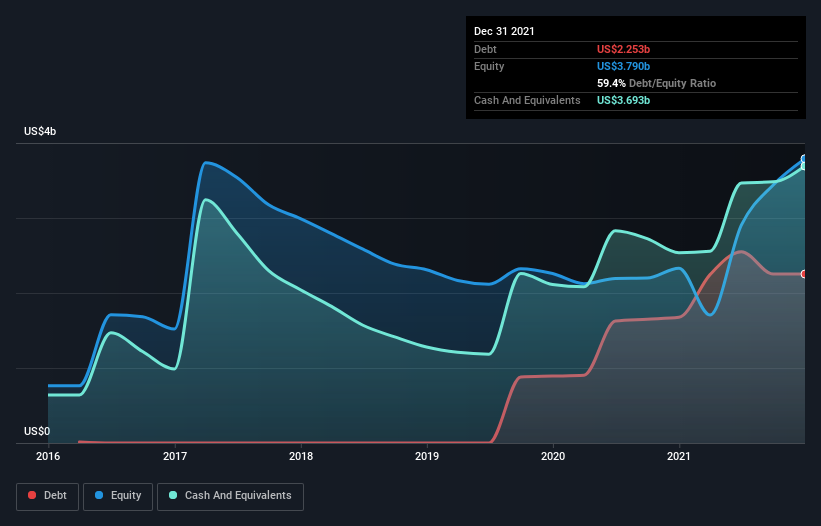Warren Buffett famously said, 'Volatility is far from synonymous with risk.' It's only natural to consider a company's balance sheet when you examine how risky it is, since debt is often involved when a business collapses. As with many other companies Snap Inc. (NYSE:SNAP) makes use of debt. But the real question is whether this debt is making the company risky.
What Risk Does Debt Bring?
Debt is a tool to help businesses grow, but if a business is incapable of paying off its lenders, then it exists at their mercy. Ultimately, if the company can't fulfill its legal obligations to repay debt, shareholders could walk away with nothing. However, a more common (but still painful) scenario is that it has to raise new equity capital at a low price, thus permanently diluting shareholders. Of course, debt can be an important tool in businesses, particularly capital heavy businesses. The first step when considering a company's debt levels is to consider its cash and debt together.
Check out our latest analysis for Snap
What Is Snap's Debt?
You can click the graphic below for the historical numbers, but it shows that as of December 2021 Snap had US$2.25b of debt, an increase on US$1.68b, over one year. However, its balance sheet shows it holds US$3.69b in cash, so it actually has US$1.44b net cash.

How Strong Is Snap's Balance Sheet?
According to the last reported balance sheet, Snap had liabilities of US$851.8m due within 12 months, and liabilities of US$2.89b due beyond 12 months. Offsetting these obligations, it had cash of US$3.69b as well as receivables valued at US$1.07b due within 12 months. So it actually has US$1.02b more liquid assets than total liabilities.
This short term liquidity is a sign that Snap could probably pay off its debt with ease, as its balance sheet is far from stretched. Succinctly put, Snap boasts net cash, so it's fair to say it does not have a heavy debt load! There's no doubt that we learn most about debt from the balance sheet. But it is future earnings, more than anything, that will determine Snap's ability to maintain a healthy balance sheet going forward. So if you want to see what the professionals think, you might find this free report on analyst profit forecasts to be interesting.
In the last year Snap wasn't profitable at an EBIT level, but managed to grow its revenue by 64%, to US$4.1b. With any luck the company will be able to grow its way to profitability.
So How Risky Is Snap?
Although Snap had an earnings before interest and tax (EBIT) loss over the last twelve months, it generated positive free cash flow of US$223m. So although it is loss-making, it doesn't seem to have too much near-term balance sheet risk, keeping in mind the net cash. Keeping in mind its 64% revenue growth over the last year, we think there's a decent chance the company is on track. There's no doubt fast top line growth can cure all manner of ills, for a stock. There's no doubt that we learn most about debt from the balance sheet. However, not all investment risk resides within the balance sheet - far from it. We've identified 3 warning signs with Snap , and understanding them should be part of your investment process.
At the end of the day, it's often better to focus on companies that are free from net debt. You can access our special list of such companies (all with a track record of profit growth). It's free.
New: Manage All Your Stock Portfolios in One Place
We've created the ultimate portfolio companion for stock investors, and it's free.
• Connect an unlimited number of Portfolios and see your total in one currency
• Be alerted to new Warning Signs or Risks via email or mobile
• Track the Fair Value of your stocks
Have feedback on this article? Concerned about the content? Get in touch with us directly. Alternatively, email editorial-team (at) simplywallst.com.
This article by Simply Wall St is general in nature. We provide commentary based on historical data and analyst forecasts only using an unbiased methodology and our articles are not intended to be financial advice. It does not constitute a recommendation to buy or sell any stock, and does not take account of your objectives, or your financial situation. We aim to bring you long-term focused analysis driven by fundamental data. Note that our analysis may not factor in the latest price-sensitive company announcements or qualitative material. Simply Wall St has no position in any stocks mentioned.
About NYSE:SNAP
Snap
Operates as a technology company in North America, Europe, and internationally.
Excellent balance sheet and good value.
Similar Companies
Market Insights
Community Narratives



